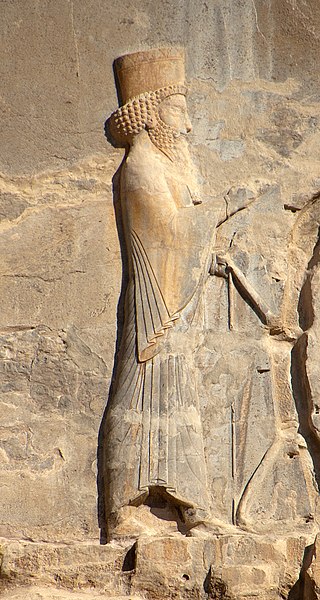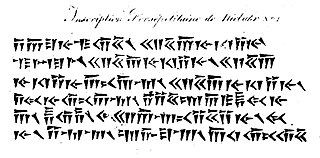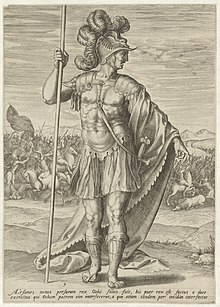
The Behistun Inscription is a multilingual Achaemenid royal inscription and large rock relief on a cliff at Mount Behistun in the Kermanshah Province of Iran, near the city of Kermanshah in western Iran, established by Darius the Great. It was important to the decipherment of cuneiform, as it is the longest known trilingual cuneiform inscription, written in Old Persian, Elamite, and Babylonian.

Darius I, commonly known as Darius the Great, was the third King of Kings of the Achaemenid Empire, reigning from 522 BCE until his death in 486 BCE. He ruled the empire at its territorial peak, when it included much of Western Asia, parts of the Balkans and the Caucasus, most of the Black Sea's coastal regions, Central Asia, the Indus Valley in the far east, and portions of North Africa and Northeast Africa including Egypt (Mudrâya), eastern Libya, and coastal Sudan.

Darius III was the last Achaemenid King of Kings of Persia, reigning from 336 BC to his death in 330 BC.

Arses, known by his regnal name Artaxerxes II, was King of Kings of the Achaemenid Empire from 405/4 BC to 358 BC. He was the son and successor of Darius II and his mother was Parysatis.

Bardiya or Smerdis, also named as Tanyoxarces by Ctesias, was a son of Cyrus the Great and the younger brother of Cambyses II, both Persian kings. There are sharply divided views on his life. Bardiya either ruled the Achaemenid Empire for a few months in 522 BCE, or was impersonated by a magus called Gaumata, whose name is given by Ctesias as Sphendadates, until he was toppled by Darius the Great.

Hyrcania is a historical region composed of the land south-east of the Caspian Sea in modern-day Iran and Turkmenistan, bound in the south by the Alborz mountain range and the Kopet Dag in the east.
Phraortes, son of Deioces, was the second king of the Median kingdom.

Ariaramnes was a great-uncle of Cyrus the Great and the great-grandfather of Darius I, and perhaps the king of Parsa, the ancient core kingdom of Persia. Ariaramnes was most likely the brother of Cyrus I of Anshan and son of Teispes, but this is not certain. In any case, he was a member of the Achaemenid House. As supported by the relief at Behistun he was the first king of a separate Achaemenid branch that ran parallel to the reigns of Cyrus I and his son Cambyses I. As the great-grandfather of Darius the Great, this line ultimately absorbs the Dynasty and dominates the Persian Empire.

Teïspes ruled Anshan in 675–640 BC. He was the son of Achaemenes of Persis and an ancestor of Cyrus the Great. There is evidence that Cyrus I and Ariaramnes were both his sons. Cyrus I is the grandfather of Cyrus the Great, whereas Ariaramnes is the great-grandfather of Darius the Great.

Media is a region of north-western Iran, best known for having been the political and cultural base of the Medes. During the Achaemenid period, it comprised present-day Iranian Azerbaijan, Iranian Kurdistan and western Tabaristan. As a satrapy under Achaemenid rule, it would eventually encompass a wider region, stretching to southern Dagestan in the north. However, after the wars of Alexander the Great, the northern parts were separated due to the Partition of Babylon and became known as Atropatene, while the remaining region became known as Lesser Media.
The Orontid dynasty, also known as the Eruandids or Eruandunis, ruled the Satrapy of Armenia until 330 BC and the Kingdom of Armenia from 321 BC to 200 BC. The Orontids ruled first as client kings or satraps of the Achaemenid Empire and after the collapse of the Achaemenid Empire established an independent kingdom. Later, a branch of the Orontids ruled as kings of Sophene and Commagene. They are the first of the three royal dynasties that successively ruled the ancient Kingdom of Armenia.

The Achaemenid dynasty was a royal house that ruled the Persian Empire, which eventually stretched from Egypt and Thrace in the west to Central Asia and the Indus Valley in the east.

Old Persian cuneiform is a semi-alphabetic cuneiform script that was the primary script for Old Persian. Texts written in this cuneiform have been found in Iran, Armenia, Romania (Gherla), Turkey, and along the Suez Canal. They were mostly inscriptions from the time period of Darius I, such as the DNa inscription, as well as his son, Xerxes I. Later kings down to Artaxerxes III used more recent forms of the language classified as "pre-Middle Persian".

Masistes was a Persian prince of the Achaemenid Dynasty, son of king Darius I and of his wife Atossa, and full brother of king Xerxes I. He was satrap (governor) of Bactria during his brother's reign, where he attempted to start a revolt in 478 BC.

Arsames was an Achaemenid satrap of ancient Egypt during the 5th century BC, at the time of the 27th Dynasty of Egypt.
The Teispids were an Iron Age branch of the Achaemenid dynasty originally ruling the southern Zagros, in ancient Anshan. The dynasty’s realm was later expanded under Cyrus II, who conquered a vast area in southwestern Asia, founding what was later known as the Achaemenid Empire under Darius I. The titulary of the Teispids is recorded on the Cyrus Cylinder, in which Cyrus II identifies himself and his ancestors with the title King of Anshan, as an Elamite tradition. Teispes being the eponymous ancestor and founder, the dynasty furthermore included Cyrus I, Cambyses I, Cyrus II, Cambyses II and Bardiya.

Hystaspes or Guštāsp, was a Persian satrap of Bactria and Persis. He was the father of Darius I, king of the Achaemenid Empire, and Artabanus, who was a trusted advisor to both his brother Darius as well as Darius's son and successor, Xerxes I.

The Achaemenid Empire or Achaemenian Empire, also known as the Persian Empire or First Persian Empire, was an Iranian empire founded by Cyrus the Great of the Achaemenid dynasty in 550 BC. Based in modern-day Iran, it was the largest empire by that point in history, spanning a total of 5.5 million square kilometres. The empire spanned from the Balkans and Egypt in the west, West Asia as the base, the majority of Central Asia to the northeast, and the Indus Valley to the southeast.

Pharnaces Ι was a son of Arsames. He was a younger brother of Hystaspes, and therefore an uncle of Achaemenid Emperor Darius I, son of Hystaspes. He was the founder of the Pharnacid dynasty that ruled over Hellespontine Phrygia.

Pissuthnes, also known as Pissouthnes, was an Achaemenid satrap of Lydia, which included Ionia, circa 440–415 BCE. His capital was Sardis. He was the son of Hystaspes, probably himself the son of Darius I, which shows his Persian origin and his membership of the Achaemenid dynasty. He held the satrapy for over twenty years, and became extremely rich as a consequence.


















